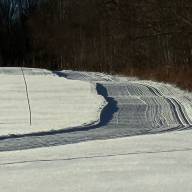By Ben Falk
Big telecom finds itself where big tobacco was in the 1960s or 1970s – an industry gold rush persisting despite thousands of scientific studies produced over decades, clearly show biological harm from exposure to the high frequency radiation produced by cellphones and particularly cell towers. If built, the new wireless transmitter will increase the background rate of radiofrequency radiation in the Airport and Dump Road neighborhoods, as well as across The Valley in the Butternut Hill area by thousands of percent. These transmitters increase electronic pollution over wide areas, (usually 0.5 to 1 square mile) from 0.000-0.005mW/m2 (the current background rate in most of Vermont) to 0.500-5.000 mW/m2.
The Federal Communication Commission (FCC) has refused to update safety measures governing cellular technology since 1996 even as 1,123 peer-reviewed studies have been published since 1990, 77% have found “significant” biological damage from wireless-radiation exposure.[1]
The mapping of “dead zones” conducted by the state in close collaboration with telecom giants has been faulty on many levels and consistently overpromised what new towers will offer (with no enforcement as to the coverage cell companies claim will be delivered), and is based on two unsound concepts:
1) that every road in Vermont should have reception and
2) that this is achievable at a tenable cost to budgets, to our experience and attractiveness of this place to out-of-staters and to the physical landscape (e.g. wildlife, soils, climate) and watershed (e.g. erosion, flood prevention).
Cellular coverage does not mean Vermont will be more attractive to businesses. The only substance in this refrain is that it’s been repeated so many times that some of us believe it. Businesses today need fast, reliable and affordable internet – at their location (unless you want to Zoom while driving). The answer to this is simple and already underway: fiberoptic cable run to town centers and later to individual homes using existing powerline infrastructure rather than new (usually steep, erosion-prone) roads which necessarily depends on blasting, bulldozing, surfacing and maintaining new roads to the wilder, more mountainous and most sensitive parts of our watershed. Fiber is already far along in reaching most Vermonters and it outperforms cellular for high bandwidth internet multiple times over in terms of cost, reliability (and data security) all while being deliverable at a much lower cost to customers and the landscape at large. EC Fiber and Waitsfield Telecom are doing a great job of it and could do more if they received half as much support as the tower-building giants have gotten.
Vermont’s crinkled terrain and need for main roads to follow the valley floors necessitate far more towers (they require direct line-of-sight) than flatter landscapes with broader valleys. Nowhere in the state’s push toward more coverage is there a serious accounting of this fundamental terrain characteristic and its implications on how much coverage is even realistic to aim for or in the projection of number of towers required.
If the state produced, along with each of their proclaimed cell coverage goals, a map showing all the new towers required and photos of each ridgeline with new towers superimposed on them, the public would at least have a chance to begin to comment intelligently on the implications at hand.
The push to develop Vermont’s landscape with cellular transmitters should be opposed on at least the following grounds:
a) lack of democratic public processes seeking citizen input;
b) lack of environmental assessment as to impacts on public health, wildlife, ecosystems, and climate change;
c) lack of accountability by telecom companies in reception coverage studies, development planning and project deliverables and;
d) lack of dubious benefits to the public bearing cellular developments and high economic cost to the public as tax dollars enable such projects.
It is, therefore, incumbent upon the public to oppose such projects. This will buy time in which policymakers can catch up with the pace of industry impact and we can democratically choose our direction. With enough civil engagement we will give ourselves the pause necessary to consider the landscape we’ve inherited which is in no small part the result of such civic involvement in the past:
A Vermont that in contrast to every single other state, chose to not defile her landscape with the commerce of billboards.
A Vermont that chose to keep her forested mountaintops intact rather than blast parkways across the tops of her watersheds.
A Vermont that chose land use policies that reduce the conversion of fields and forests into subdivisions, parking lots and shopping plazas.
These were borne of public engagement, sacrifice and vision, and a refusal to let the winds of commerce alone determine the future of our valleys and hills. Will we look up from our devices long enough to notice where we are headed and do something about it? We can support a working landscape and the Defreests our neighbors, while we oppose a trajectory that is at odds with the spirit, history, and highest possibilities of Vermont.
Falk lives in Moretown and became interested in electronic pollution though beekeeping.
[1] https://www.propublica.org/article/fcc-5g-wireless-safety-cellphones-risk.












